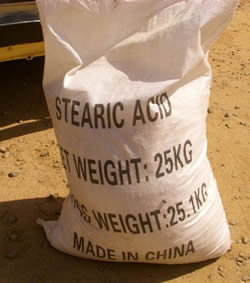Examples of skin care ingredients not necessarily already known to be harmful are stearic acid and stearates. Indeed, stearic acid is a healthful saturated fatty acid eighteen carbon atoms long, and it comprises 20 to 25 percent of tallow and therefore about half of the saturated fat found in tallow. The main sources of stearic acid are tallow and chocolate; in other foods, it only occurs at the level of 1 to 2 percent. (32)
 While stearic acid helps make tallow a unique and healthful substance, the purpose for which commercially fractionated stearic acid is used is entirely different. It is used as a "surfactant cleansing agent" and "surfactant emulsifying agent" (33). Another concern is its source and the methods used to isolate it so that it actually ends up being a chemically named ingredient rather than a component of a whole substance found in nature. "Stearic acid is prepared by treating animal and vegetable fats and oils with water at a high pressure and temperature (above 200°C [400°F]), leading to the hydrolysis of triglycerides. The resulting mixture is then distilled." (34)
While stearic acid helps make tallow a unique and healthful substance, the purpose for which commercially fractionated stearic acid is used is entirely different. It is used as a "surfactant cleansing agent" and "surfactant emulsifying agent" (33). Another concern is its source and the methods used to isolate it so that it actually ends up being a chemically named ingredient rather than a component of a whole substance found in nature. "Stearic acid is prepared by treating animal and vegetable fats and oils with water at a high pressure and temperature (above 200°C [400°F]), leading to the hydrolysis of triglycerides. The resulting mixture is then distilled." (34)
Stearates are compounds "containing" stearic acid. They include "salts" of stearic acid, such as sodium stearate, where the hydrogen of the carboxyl group (-COOH) on the end of the molecule is replaced with sodium, and it is actually a soap or detergent. "The stearate salts are generally used for their lubricating properties. They also help to keep emulsions from separating into their oil and liquid components. The stearate salts increase the thickness of the lipid (oil) portion of cosmetics and personal care products and reduce the clear or transparent appearance of finished products." (35)
Stearates also include esters of stearic acid, such as glyceryl stearate, where a molecule of glycerin is bonded to the oxygen in place of that same hydrogen. "Glyceryl stearate acts as a lubricant on the skin's surface, which gives the skin a soft and smooth appearance. It also slows the loss of water from the skin by forming a barrier on the skin's surface. Glyceryl stearate, and glyceryl stearate SE [(self-emulsifying)] help to form emulsions by reducing the surface tension of the substances to be emulsified. Glyceryl stearate is made by reacting glycerin with stearic acid, a fatty acid obtained from animal and vegetable fats and oils. Glyceryl stearate SE is produced by reacting an excess of stearic acid with glycerin. The excess stearic acid is then reacted with potassium and/or sodium hydroxide yielding a product that contains glyceryl stearate as well as potassium stearate and/or sodium stearate." (36) Yet again, we do not find a healthful reason stated for using these chemical compounds on our skin.
 At first sight, it would seem that these compounds, related to a healthful component of tallow, are a sign of imitating nature, but that does not appear to be their purpose at all. In addition, after all of this fractionating and chemical compounding, they are a far cry from the naturally occurring stearic acid found in tallow as part of a whole food, even without considering the fact that they are commonly produced from genetically modified organisms (GMO's).
At first sight, it would seem that these compounds, related to a healthful component of tallow, are a sign of imitating nature, but that does not appear to be their purpose at all. In addition, after all of this fractionating and chemical compounding, they are a far cry from the naturally occurring stearic acid found in tallow as part of a whole food, even without considering the fact that they are commonly produced from genetically modified organisms (GMO's).
This is a good place to note a couple of reasons why the industry does not create products like Tallow Balm for skin care. Products directly from nature cannot be proprietary (especially not if you can make them in your own kitchen). In addition, products from nature are not always consistent and predictable since each batch can vary according to the season, the source, and so on. This variance does not fit the industrial model, even the health food store industrial model. The safest and most healthful course is in the use of whole food substances from nature, and therefore we should use tallow as our ancestors did.
Read on: Not Just Any Tallow
References:
32. Enig, Mary G., PhD (Spring 2004). Wise Traditions in Food, Farming and the Healing Arts. "The Importance of Saturated Fats for Biological Functions".
33. Personal Care Products Council. "Stearic Acid". (http://www.cosmeticsinfo.org/ingredient_details.php?ingredient_id=12)
34. Anneken, David J., Both, Sabine, et al. (2006). "Fatty Acids". Ullmann's Encyclopedia of Industrial Chemistry. Wiley-VCH, Weinheim.
35. Personal Care Products Council. "Sodium Stearate". (http://www.cosmeticsinfo.org/ingredient_details.php?ingredient_id=961)
36. Personal Care Products Council. "Glyceryl Stearate". (http://www.cosmeticsinfo.org/ingredient_details.php?ingredient_id=498)
